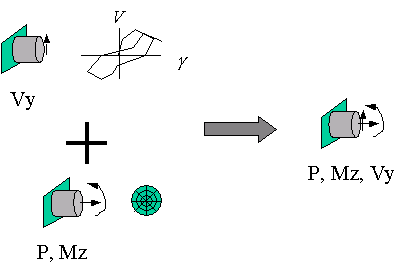Section Aggregator: Difference between revisions
No edit summary |
No edit summary |
||
| (One intermediate revision by one other user not shown) | |||
| Line 29: | Line 29: | ||
|- | |- | ||
| || T Torsion Force-Deformation | | || T Torsion Force-Deformation | ||
|- | |||
| '''$sectionTag''' || tag of previously-defined Section object to which the UniaxialMaterial objects are aggregated as additional force-deformation relationships | |||
|} | |} | ||
| Line 39: | Line 41: | ||
section Aggregator 2 2 Vy -section 4; # create new section with IDtag 2, taking the existing material tag 2 to represent the shear and adding it to the existing section tag 4, which may be a fiber section where the interaction betweeen axial force and flexure is already considered. | section Aggregator 2 2 Vy -section 4; # create new section with IDtag 2, taking the existing material tag 2 to represent the shear and adding it to the existing section tag 4, which may be a fiber section where the interaction betweeen axial force and flexure is already considered. | ||
THEORY: | |||
Read if you're using moment-curvature in beamWithHinges element to represent moment-rotation, or vice versa | |||
http://earthquakespectra.org/doi/abs/10.1193/1.4000136 | |||
---- | ---- | ||
Code Developed by: <span style="color:blue"> Micheal H. Scott, Oregon State </span> | Code Developed by: <span style="color:blue"> Micheal H. Scott, Oregon State </span> | ||
Latest revision as of 23:15, 13 August 2013
- Command_Manual
- Tcl Commands
- Modeling_Commands
- model
- uniaxialMaterial
- ndMaterial
- frictionModel
- section
- geometricTransf
- element
- node
- sp commands
- mp commands
- timeSeries
- pattern
- mass
- block commands
- region
- rayleigh
- Analysis Commands
- Output Commands
- Misc Commands
- DataBase Commands
This command is used to construct a SectionAggregator object which aggregates groups previously-defined UniaxialMaterial objects into a single section force-deformation model. Each UniaxialMaterial object represents the section force-deformation response for a particular section degree-of-freedom (dof). There is no interaction between responses in different dof directions. The aggregation can include one previously defined section.
| section Aggregator $secTag $matTag1 $dof1 $matTag2 $dof2 ....... <-section $sectionTag> |
| $secTag | unique section tag |
| $matTag1 $matTag2 ... | tag of previously-defined UniaxialMaterial objects |
| $dof1 $dof2 ... | the force-deformation quantity to be modeled by this section object. One of the following section dof may be used: |
| P Axial force-deformation | |
| Mz Moment-curvature about section local z-axis | |
| Vy Shear force-deformation along section local y-axis | |
| My Moment-curvature about section local y-axis | |
| Vz Shear force-deformation along section local z-axis | |
| T Torsion Force-Deformation | |
| $sectionTag | tag of previously-defined Section object to which the UniaxialMaterial objects are aggregated as additional force-deformation relationships |
EXAMPLE
section Aggregator 2 2 Vy -section 4; # create new section with IDtag 2, taking the existing material tag 2 to represent the shear and adding it to the existing section tag 4, which may be a fiber section where the interaction betweeen axial force and flexure is already considered.
THEORY:
Read if you're using moment-curvature in beamWithHinges element to represent moment-rotation, or vice versa
http://earthquakespectra.org/doi/abs/10.1193/1.4000136
Code Developed by: Micheal H. Scott, Oregon State
